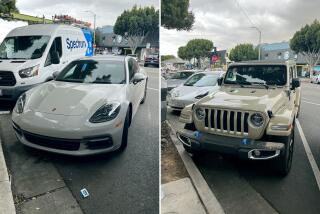Making Sure the Paint Measures Up
- Share via
Amid all the technological advances in automobiles, it’s almost easy to overlook one of the biggest areas of change in the past decade: the paint.
The new paints look good, judging by consumer acceptance. They have brilliant colors and excellent deep shines, thanks to clear plastic top coats.
But whether they hold up is matter of dispute, judging by lawsuits and consumer actions seeking recalls.
This much is certain: auto makers have had a tough job providing good looking, durable paint jobs that comply with strict new environmental regulations on the emissions of solvents from factories.
Ted Lasko, General Motor’s manager for paint development in Detroit, said GM cars have never been painted better--even in the 1950s and 1960s, when multiple layers of lacquer-based paints with generous amounts of lead were hand-sprayed at the factory.
“Lead is out, but the acrylic paints today are stronger and, with the clear coat, the (weather) doesn’t get to the color coat,” Lasko said. “In the past with lacquer, they cracked and split quite quickly in some cases.”
Today’s paint processes are much changed, although almost no two GM plants use the same one. The paints vary in type and in the number of coats on any given model, Lasko said.
But whether you buy a $35,000 Cadillac or a $12,000 Chevy, GM’s intent is to give the same quality paint job, Lasko said. More expensive models do not have higher quality paints, more coats or a different method of application--as amazing as that may seem.
The first coat is applied after the body is assembled. The car is dipped into primer, which is electrically charged. The car body carries an opposite charge, which helps to bond the paint to the metal.
The primer is baked at 325 degrees for half an hour. Then sealers are used to fill any gaps in the sheet metal.
A base coat of color is next. At some GM plants, this is done with a single pass of a robotic sprayer. At other plants, two coats are applied. Finally, while the base coat is still wet, one or two coats of clear acrylic or urethane are applied. Then, the car is baked a second time at 250 degrees to 275 degrees for half an hour.
The result is a paint film that is three to five mils thick (a mil is one-thousandth of an inch). Lasko said the paint process used in the past did not provide a thicker coat of paint, although many auto body experts disagree.
What has changed most significantly is the composition of the paints. They have fewer solvents and more solids, which emit less pollution. And although the paints are called acrylic and urethane enamels, they are water-based.
Lasko insists that the switch to water-based, high-solid paints has not affected durability or appearance, but some other experts are less certain.
Ken Zion, a collision and auto-body consultant who also teaches at El Camino College, said new paints are more fragile. A bird dropping, for example, can eat right through some of the new clear coats.
And GM lost a major Lemon Law case last month in Los Angeles, when an arbitrator ordered the company to pay damages of $173,043 because of defects in the paint on a Chevrolet Blazer. Attorney David Scott Levaton argued that different body panels on the Blazer did not match and that the paint was chipping off.
The award was one of the biggest ever handed out and included a substantial civil penalty for GM’s reluctance to deal with the problem earlier.





